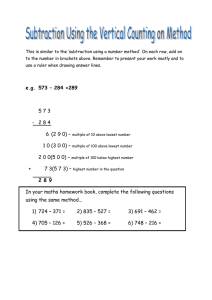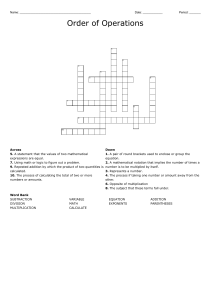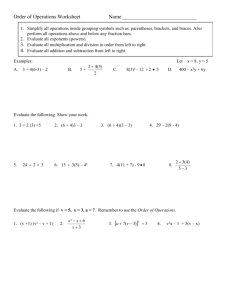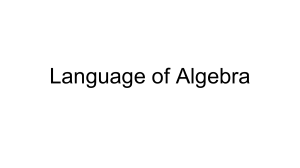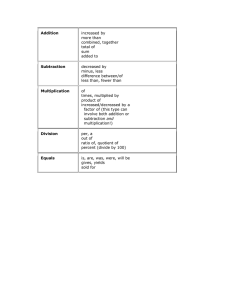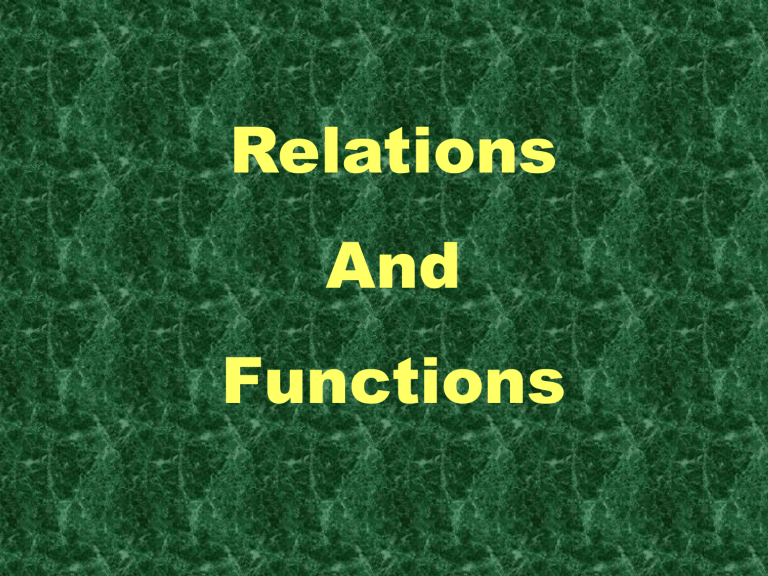
Relations
And
Functions
A relation is a set of ordered pairs.
The domain is the set of all x values in the relation
domain = {-1,0,2,4,9}
These are the x values written in a set from smallest to largest
{(2,3), (-1,5), (4,-2), (9,9), (0,-6)}
These are the y values written in a set from smallest to largest
range = {-6,-2,3,5,9}
The range is the set of all y values in the relation
This is a
relation
A relation assigns the x’s with y’s
1
2
3
4
2
4
6
5
8
10
Domain (set of all x’s)
Range (set of all y’s)
This relation can be written {(1,6), (2,2), (3,4), (4,8), (5,10)}
AAfunction
function fffrom
fromset
setAAto
toset
setBBisisaarule
ruleof
ofcorrespondence
correspondence
that
thatassigns
assigns to
toeach
eachelement
element xxin
in the
theset
setAAexactly
exactly one
element
element yyin
inthe
theset
setB.
B.
1
2
3
4
5
2
4
6
8
10
Set A is the domain
What
This is a Whew!
function
did that
---it meets
oursay?
conditions
Set B is the range
Must use all the x’s
The x value can only be assigned to one y
Let’s look at another relation and decide if it is a function.
The second condition says each x can have only one y, but it CAN
be the same y as another x gets assigned to.
1
2
3
4
5
2
4
6
8
10
Set A is the domain
This is a function
---it meets our
conditions
Set B is the range
Must use all the x’s
The x value can only be assigned to one y
goodexample
examplethat
thatyou
youcan
can“relate”
“relate”totoisisstudents
studentsininour
our
AAgood
mathsclass
classthis
thissemester
semesterare
areset
setA.A. The
Thegrade
gradethey
theyearn
earnout
out
maths
theclass
classisisset
setB.B. Each
Eachstudent
studentmust
mustbe
beassigned
assignedaagrade
grade
ofofthe
andcan
canonly
only be
be assigned
assigned ONE
and
ONE grade,
grade,but
butmore
morethan
thanone
one
studentcan
canget
getthe
thesame
samegrade
grade(we
(wehope
hopeso---we
so---wewant
wantlots
lotsof
student
of A’s).
example
show
previous
screen
had
each
A’s).
TheThe
example
shown
onon
thethe
previous
screen
had
each
studentgetting
gettingthe
thesame
samegrade.
grade. That’s
That’sokay.
okay.
student
1
2
3
4
5
2
4
6
8
10
2 was assigned both 4 and 10
Is the relation shown above a function?
NO
Why not???
Check this relation out to determine if it is a function.
It is not---3 didn’t get assigned to anything
Comparing to our example, a student in maths must receive a grade
1
2
3
4
5
Set A is the domain
2
4
6
8
10
Set B is the range
This is not a
Must use all the x’s
function---it
doesn’t assign
each x with a y The x value can only be assigned to one y
Check this relation out to determine if it is a function.
This is fine—each student gets only one grade. More than one can
get an A and I don’t have to give any D’s (so all y’s don’t need to be
used).
1
2
3
4
5
2
4
6
8
10
Set A is the domain
This is a function
Set B is the range
Must use all the x’s
The x value can only be assigned to one y
We commonly call functions by letters. Because function
starts with f, it is a commonly used letter to refer to
functions.
f x 2 x 3x 6
2
This means
the right
hand side is
a function
called f
This means
the right hand
side has the
variable x in it
The left side DOES NOT
MEAN f times x like
brackets usually do, it
simply tells us what is on
the right hand side.
The left hand side of this equation is the function notation.
It tells us two things. We called the function f and the
variable in the function is x.
Remember---this tells you what
is on the right hand side---it is
not something you work. It says
that the right hand side is the
function f and it has x in it.
f x 2 x 3x 6
2
f 2 22 32 6
2
f 2 24 32 6 8 6 6 8
So we have a function called f that has the variable x in it.
Using function notation we could then ask the following:
This means to find the function f and instead of
having an x in it, put a 2 in it. So let’s take the
Find f (2).
function above and make brackets everywhere
the x was and in its place, put in a 2.
Don’t forget order of operations---powers, then
multiplication, finally addition & subtraction
Find f (-2).
f x 2 x 3x 6
2
f 2 2 2 3 2 6
2
f 2 24 3 2 6 8 6 6 20
This means to find the function f and instead of having an x
in it, put a -2 in it. So let’s take the function above and make
brackets everywhere the x was and in its place, put in a -2.
Don’t forget order of operations---powers, then
multiplication, finally addition & subtraction
f x 2 x 3x 6
2
Find f (k).
f k 2k 3k 6
2
f k 2 k 3k 6 2k 3k 6
2
2
This means to find the function f and instead of having an x
in it, put a k in it. So let’s take the function above and make
brackets everywhere the x was and in its place, put in a k.
Don’t forget order of operations---powers, then
multiplication, finally addition & subtraction
f x 2 x 3x 6
2
Find f (2k).
f 2k 22k 32k 6
2
f 2k 2 4k 32k 6 8k 6k 6
2
2
This means to find the function f and instead of having an x in
it, put a 2k in it. So let’s take the function above and make
brackets everywhere the x was and in its place, put in a 2k.
Don’t forget order of operations---powers, then
multiplication, finally addition & subtraction
Let's try a new function
Find g(1)+ g(-4).
g x x 2 x
2
g 1 1 21 1
2
g 4 4 2 4 16 8 24
2
So g 1 g 4 1 24 23
The last thing we need to learn about functions for
this section is something about their domain. Recall
domain meant "Set A" which is the set of values you
plug in for x.
For the functions we will be dealing with, there
are two "illegals":
1. You can't divide by zero (denominator (bottom)
of a fraction can't be zero)
2. You can't take the square root (or even root) of
a negative number
When you are asked to find the domain of a function,
you can use any value for x as long as the value
won't create an "illegal" situation.
Find the domain for the following functions:
Since no matter what value you
choose for x, you won't be dividing
f x 2x 1 by zero or square rooting a negative
number, you can use anything you
Note: There is
want so we say the answer is:
nothing wrong with
the top = 0 just means All real numbers x.
the fraction = 0
x3
g x
x2
illegal if this
is zero
If you choose x = 2, the denominator
will be 2 – 2 = 0 which is illegal
because you can't divide by zero.
The answer then is:
All real numbers x such that x ≠ 2.
means does not equal
Let's find the domain of another one:
h x x 4
Can't be negative so must be ≥ 0
x4 0
solve
this
x4
We have to be careful what x's we use so that the second
"illegal" of square rooting a negative doesn't happen. This
means the "stuff" under the square root must be greater
than or equal to zero (maths way of saying "not negative").
Summary of How to Find the
Domain of a Function
• Look for any fractions or square roots that could cause one
of the two "illegals" to happen. If there aren't any, then the
domain is All real numbers x.
• If there are fractions, figure out what values would make the
bottom equal zero and those are the values you can't use.
The answer would be: All real numbers x such that x ≠
those values.
• If there is a square root, the "stuff" under the square root
cannot be negative so set the stuff ≥ 0 and solve. Then
answer would be: All real numbers x such that x is defined
by whatever you got when you solved.
NOTE: Of course your variable doesn't have to be x, can be
whatever is in the problem.
